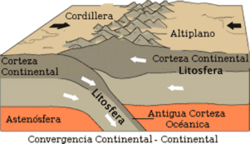Convergent edge
A convergent edge or destructive edge is the collision edge between two tectonic plates. When at the convergent edge, one of the lithosphere plates sinks below the other, consuming itself in the mantle, it is called subduction. This type of edges leads to the formation of mountain ranges and is associated with zones of volcanic and seismic activity caused by the friction of the two plates.
Types of converging edges
Depending on the type of crust involved, three types of convergent edges can be distinguished:
Oceanic-continental convergence
A plate with oceanic crust collides with a plate with continental crust which, being lighter, "floats" on the oceanic that sinks (subducts) in the mantle. Upon reaching a depth of about 100 km, partial melting is triggered, which causes an ascending flow of magma (molten rock) that causes plutons and volcanoes that grow on the continent. Thus, continental volcanic arcs and large oceanic trenches are formed, both parallel to the coast. The intersection point of the two plates is called the subduction zone and there an oceanic trench is formed where sediments accumulate in a structure called an accretionary prism.
This type of convergent edge occurs on the Pacific coast of South America, where the fully oceanic Nazca plate drifts to the east and collides with the South American plate that drifts to the west; The ascending magma has formed the Andes mountain range, with hundreds of active volcanoes and intense seismic activity.
Ocean-Ocean Convergence
When two plates with oceanic crust collide. One plate subducts under the other, starting melting and volcanic activity as in the oceanic-continental convergence. These arcs are located 100-300 km from the submarine trench that forms at the subduction point. Examples of archipelagos thus originated are the Aleutians, the Mariana Islands, Tonga, Japan, and the Sunda Islands, and the trenches associated with them.
Continental-Continental Convergence
When a subducting oceanic plate also contains continental lithosphere, continued subduction will eventually unite the two continental blocks which, since both float on the asthenosphere, will collide. This folds and deforms the accumulated sediments along the continental margin, originating a new mountain range composed of sedimentary and metamorphosed rocks.
This type of phenomenon occurred when India "rammed" Asia and caused the elevation of the Himalayas. Other important mountain systems, such as the Pyrenees, the Alps, and the Urals, also originated during continental collisions.
Contenido relacionado
Triassic
Pedrosillo de Alba
Subduction



